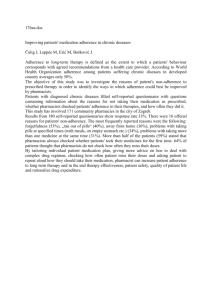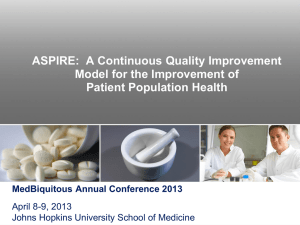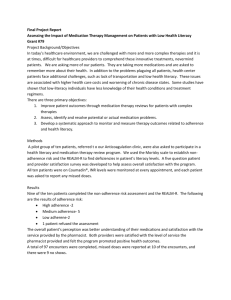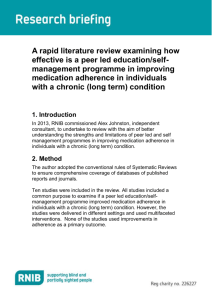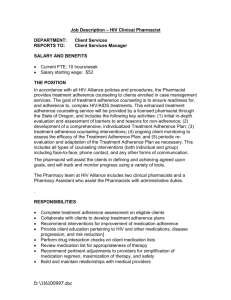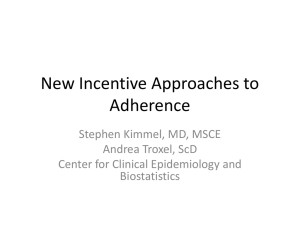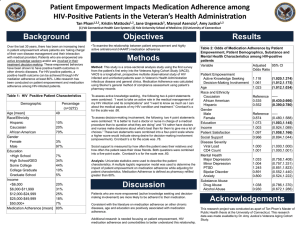From Formulation to Drug Delivery to Specialty Packaging: A
advertisement
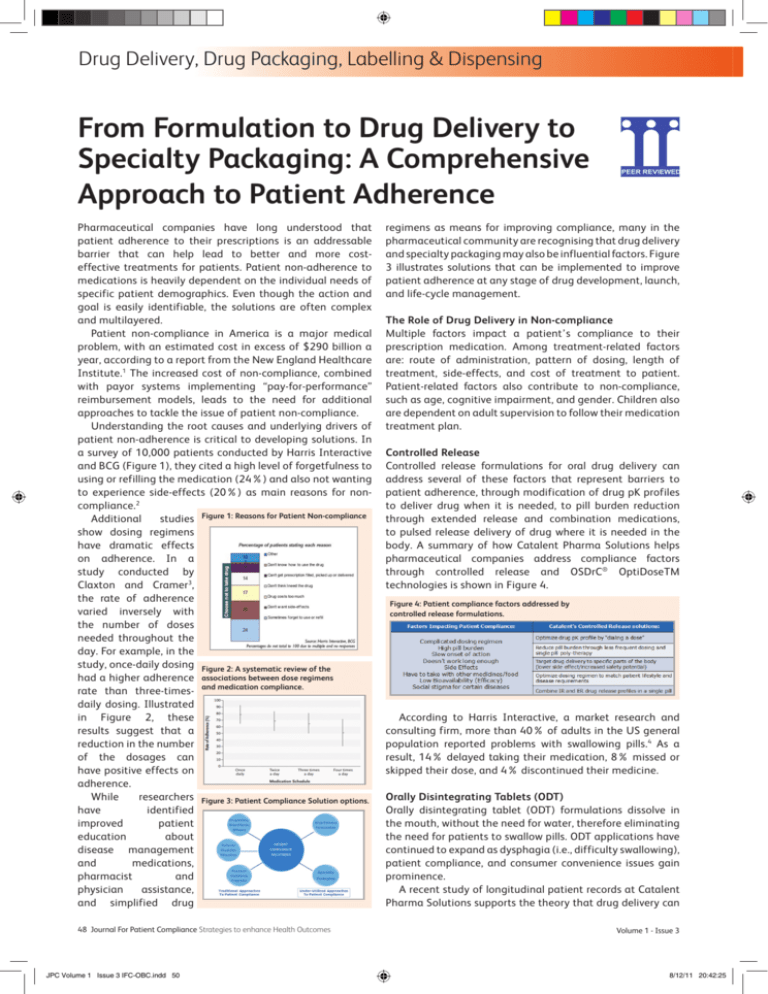
Drug Delivery, Drug Packaging, Labelling & Dispensing From Formulation to Drug Delivery to Specialty Packaging: A Comprehensive Approach to Patient Adherence Pharmaceutical companies have long understood that patient adherence to their prescriptions is an addressable barrier that can help lead to better and more costeffective treatments for patients. Patient non-adherence to medications is heavily dependent on the individual needs of specific patient demographics. Even though the action and goal is easily identifiable, the solutions are often complex and multilayered. Patient non-compliance in America is a major medical problem, with an estimated cost in excess of $290 billion a year, according to a report from the New England Healthcare Institute.1 The increased cost of non-compliance, combined with payor systems implementing “pay-for-performance” reimbursement models, leads to the need for additional approaches to tackle the issue of patient non-compliance. Understanding the root causes and underlying drivers of patient non-adherence is critical to developing solutions. In a survey of 10,000 patients conducted by Harris Interactive and BCG (Figure 1), they cited a high level of forgetfulness to using or refilling the medication (24%) and also not wanting to experience side-effects (20%) as main reasons for noncompliance.2 Additional studies Figure 1: Reasons for Patient Non-compliance show dosing regimens have dramatic effects on adherence. In a study conducted by Claxton and Cramer3, the rate of adherence varied inversely with the number of doses needed throughout the day. For example, in the study, once-daily dosing Figure 2: A systematic review of the had a higher adherence associations between dose regimens rate than three-times- and medication compliance. daily dosing. Illustrated in Figure 2, these results suggest that a reduction in the number of the dosages can have positive effects on adherence. While researchers Figure 3: Patient Compliance Solution options. have identified improved patient education about disease management and medications, pharmacist and physician assistance, and simplified drug 48 Journal For Patient Compliance Strategies to enhance Health Outcomes JPC Volume 1 Issue 3 IFC-OBC.indd 50 regimens as means for improving compliance, many in the pharmaceutical community are recognising that drug delivery and specialty packaging may also be influential factors. Figure 3 illustrates solutions that can be implemented to improve patient adherence at any stage of drug development, launch, and life-cycle management. The Role of Drug Delivery in Non-compliance Multiple factors impact a patient’s compliance to their prescription medication. Among treatment-related factors are: route of administration, pattern of dosing, length of treatment, side-effects, and cost of treatment to patient. Patient-related factors also contribute to non-compliance, such as age, cognitive impairment, and gender. Children also are dependent on adult supervision to follow their medication treatment plan. Controlled Release Controlled release formulations for oral drug delivery can address several of these factors that represent barriers to patient adherence, through modification of drug pK profiles to deliver drug when it is needed, to pill burden reduction through extended release and combination medications, to pulsed release delivery of drug where it is needed in the body. A summary of how Catalent Pharma Solutions helps pharmaceutical companies address compliance factors through controlled release and OSDrC® OptiDoseTM technologies is shown in Figure 4. Figure 4: Patient compliance factors addressed by controlled release formulations. According to Harris Interactive, a market research and consulting firm, more than 40% of adults in the US general population reported problems with swallowing pills.4 As a result, 14% delayed taking their medication, 8% missed or skipped their dose, and 4% discontinued their medicine. Orally Disintegrating Tablets (ODT) Orally disintegrating tablet (ODT) formulations dissolve in the mouth, without the need for water, therefore eliminating the need for patients to swallow pills. ODT applications have continued to expand as dysphagia (i.e., difficulty swallowing), patient compliance, and consumer convenience issues gain prominence. A recent study of longitudinal patient records at Catalent Pharma Solutions supports the theory that drug delivery can Volume 1 - Issue 3 8/12/11 20:42:25 Drug Delivery, Drug Packaging, Labelling & Dispensing improve patient medication compliance. The one-year study compared the compliance rates of two oral delivery methods for delivery of selegiline, a treatment for Parkinson’s disease: standard pill and an orally disintegrating tablet (ODT) formulation that achieved pre-gastric absorption. Results showed a 98.5% compliance rate with the ODT formulation compared to 81% with the standard oral treatment in US Medicare patients, shown in Figure 5.5 Figure 5: Zydis® fast-dissolve tablet patient compliance compared to traditional tablet formulations. This same patient records study showed an improvement in compliance across all patients studied. Additionally, Zydis® ODT formulations have shown patient preference and improved compliance in other therapeutic applications compared to traditional tablets, shown in Figure 6. by analysing a cohort of ~200,000 qualified patients who filled their prescriptions in either a traditional bottle or a patient adherence package. Persistency rates were defined as the percentage of patients who remained compliant or restarted therapy over the 12-month tracking cycle. The new study strongly correlated improved adherence rates with the packaging format. The patient adherence packaging led to a 17-point increase in patient persistency to a drug over 12 months, as compared to the 30-count bottle. To most effectively enhance the packaging to drive patient adherence, the package must incorporate multiple adherence drivers customised to the needs of the specific therapeutic area. Many features can be added to the package to address an array of barriers to medication adherence. For example, different features for opening the package can allow for easier use and create a positive initial experience with the medication. Titration packages are a prime example of adherence-prompting packages. These designs simplify the dosing process for the patient through their format and drug layout, while reminder-prompting features such as the printing of dates, numbering, or icons encourages the patient to take the right medication dose at the right time, as illustrated in Figure 7. Figure 7: Titration Package. Figure 6: Zydis® fast-dissolve tablet patient preference and adherence data summary. The Role of Specialty Packaging in Non-compliance Specialty packaging is another piece of the patient medication adherence puzzle that appears to have a significant impact on patient persistency and patient outcomes. “The Impact of Innovative Packaging on Adherence and Treatment Outcomes in Elderly Patients with Hypertension”, often referred to as the Ohio State Study,10 and the Federal Study of Adherence to Medications in the Elderly (FAME), which observed the impact of a comprehensive pharmacy care programme on medication adherence and control of blood pressure and low-density lipoprotein cholesterol (LDL-C),11 are two studies that are often cited to highlight the positive correlation between specialty packaging and improved patient medication adherence. To further support the influence packaging formats have on patient adherence, Catalent conducted a study with SDI in January 2011 to measure patient persistency to a medication by comparing a unit-dose patient adherence package to a conventional 30-count bottle package for the same drug12. The study utilised patient prescription data from SDI, a provider of anonymous patient-based prescription data. The data set are from claims from more than 50% of the retail pharmacies in the United States, and account for one-half of dispensed claims across all pay types. This adherence study looked at patient persistency rates over a 12-month period www.JforPC.com JPC Volume 1 Issue 3 IFC-OBC.indd 51 Summary Medication non-adherence is recognised as a major issue that burdens our healthcare system, and in many cases can impact patient outcomes. Developing drugs with optimal safety/efficacy/side-effect profiles; patient, physician, and pharmacy education programmes; and patient payment assistance programmes are a common focus for pharmaceutical companies to address patient adherence. Additional and proven solutions, such as drug delivery formulation and specialty packaging, exist to improve patient adherence and are sometimes overlooked in the pharmaceutical industry. Moreover, the root cause for patient non-adherence is multi-factorial, requiring solutions that are both multilayered and multifunctional within the pharmaceutical industry. These solutions bridge across drug development, drug delivery formulation, and specialty packaging, and are enhanced post-launch through patient/physician/pharmacy education programmes and patient access programmes. This cross-functional solution approach is the foundation of Catalent’s new programme to enhance patient adherence, called Adherence by Design™ (described in Figure 8). This programme is derived from the Quality by Design (QbD) philosophy, which starts with the desired outcome and then works backwards in the process to control the critical parameters. Journal For Patient Compliance Strategies to enhance Health Outcomes 49 8/12/11 20:42:39 Drug Delivery, Drug Packaging, Labelling & Dispensing Figure 8: Catalent’s Adherence by Design™ programme. Key stakeholders in Adherence by Design™ programmes look at multiple parameters early in the drug development cycle and then build in features that will help promote adherence for the specific therapeutic class. This unique approach throughout the product development life-cycle can create a tailored solution designed to drive increased patient medication adherence. Figure 9 describes the potential Figure 9: Adherence by Design™ programme potential adherence benefits and technologies. SDI Health, a division of IMS Health, conducted in January, 2011. Study included 1520 US patients prescribed Zelapar, Eldepryl, or generic Selegiline. 6. Clarke A, Johnson ES, Mallard N, Corn TH, Johnston A, Boyce M, Warrington S, MacMahon DG, A new low-dose formulation of selegiline: clinical efficacy, patient preference and selectivity for MAO-B inhibition, J Neural Transm. 2003 Nov 27;110(11):12571271. 7. G iorgio Ciprandi, Clinical Utility and patient adherence with ebastine for allergic rhinitis, Patient preference and adherence, Volume 4, PubMed Central, October 14, 2010. 8. Karagianis J, Grossman L, Landry J, et al., A randomized controlled trial of the effect of sublingual orally disintegrating olanzapine versus oral olanzapine on the body mass index: The PLATYPUS study. Schizophr Res. 2009; 113:41-48. 9. R eig AR, Fernandez JP, Cervera JG, Navarro JH, Ferragud MA, Hortal EG, Acceptance survey of a fast dissolving tablet pharmaceutical formulation in allergic patients. Satisfaction and expectancies. Allergol Immunopathol. 206; 34:107-112. 10. S chneider P, Murphy J & Pedersen C. The Impact of Medication Packaging on Adherence and Treatment Outcomes in Older Ambulatory Patients. Journal of the American Pharmacists Association, 48(1), 58-63. 11. Lee J, Grace K &Taylor A (2006), Federal Study of Adherence to Medications (FAME): Effect of Pharmacy Care Program on Medication Adherence and Persistence, Blood Pressure and Low-Density Lioprotein Cholesterol: A Randomized Controlled Trial. JAMA 296,2563-2571. 12. C atalent/SDI study “Compliance packaging study utilizing claims data” (2011) Zydis® is a registered trademark of Catalent Pharma Solutions OSDrC® is a registered trademark of Sanwa Kagaku Kenkyusho Co., Ltd. OptiDose is a registered trademark of Catalent Pharma Solutions Zelapar® is a registered trademark of Valeant Pharmaceuticals North America Corp. Eldepryl® is a registered trademark of Somerset Pharmaceuticals, Inc adherence benefits and corresponding technologies. The drug delivery and specialty packaging format can be revisited at multiple points in the product life-cycle, and may ultimately play a key role in enhancing patient medication adherence. As the cost burden of patient non-adherence continues to increase and payor systems alter their reimbursement models, the healthcare industry will be forced to redefine ways to improve the overall system. The adoption of more comprehensive patient adherence solutions can assist in enhancing patient outcomes and improving adherence results. References 1. N ew England Healthcare Institute, Thinking Outside the Pillbox, A System-wide Approach to Improving Patient Medication Adherence for Chronic Disease, August 2009. 2. H arris Interactive and BCG 2002 Survey on reasons for patient non adherence. 3. Claxton AJ, Cramer J, Pierce C. A systematic review of the associations between dose regimens and medication compliance. Clin Ther. 2001;23(8):1296–1310. 4. P RNewswire, website: http://www.spraynswallow.com/ links&Articles.html, January 15, 2004. 5. 1 2-month longitudinal patient records analysis conducted by 50 Journal For Patient Compliance Strategies to enhance Health Outcomes JPC Volume 1 Issue 3 IFC-OBC.indd 52 Steven Hamlen is Group Product Manager for Catalent’s Modified Release Technologies. He has 19 years’ experience in the life sciences industry and prior to joining Catalent, held a number of senior positions within leading pharmaceutical companies developing life-cycle strategies for new molecules, and those approaching patent expiry. Steven has a BS in Chemical Engineering and an MBA from Lehigh University. Email: steven.hamlen@catalent.com Bill Hartzel is a Product Manager for Catalent’s Medication Delivery Solutions division. He specialises in patient adherence solutions and has worked with many of customers’ brand management teams to understand and design adherence solutions for their products’ specific needs. Prior to joining Catalent Bill held roles within the biopharmaceutical industry and specialised in material selection for single-use devices. He also held leadership positions within several industry organisations including ASME BPE and BPSA. Bill has a B.Sc. in Chemical Engineering and an expected MBA from Villanova University. Email: bill.hartzel@catalent.com Volume 1 - Issue 3 8/12/11 19:42:29
